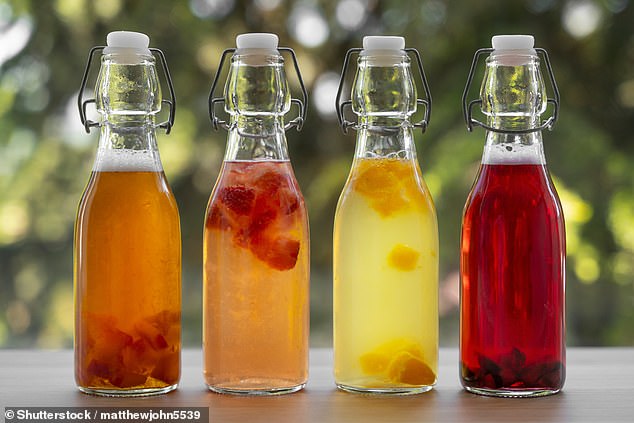Kombucha used to be “just” the carbonated, vinegar-flavored health drink you could find at farmers markets. But now it is truly common.
Fermented tea, first brewed in China more than 2,000 years ago, where it is considered the “elixir of life” and used to boost immunity and maintain the digestive system, is now widely available in pubs, cafes and supermarkets. .
Statistics show that the UK consumed 4.4 million liters of kombucha last year, an increase of more than 800,000 liters on the previous year. Its success is attributed to our growing appetite for ‘functional health drinks’ that quench our thirst and provide health benefits, says Charlotte Foster, specialist dietitian at Barts Health NHS Trust.
In the case of kombucha, these health benefits are believed to largely derive from the fermentation process the drink goes through.
This produces probiotics (beneficial bacteria) that are thought to help maintain the gut microbiome, the collection of microorganisms that live in the digestive tract and are important for everything from supporting our immune system to influencing our risk of being overweight.
Kombucha, a fermented tea first made in China more than 2,000 years ago, is used to boost immunity and maintain the digestive system.
Additionally, the tea element “provides antioxidants, which help with inflammation, and B vitamins, which are essential for bodily functions such as the metabolism of carbohydrates and dietary proteins,” says Charlotte Foster.
“And it’s these potential benefits, in addition to generally being low in calories and sugar, that people accept when they buy it,” he adds.
But as more producers jump on the bandwagon, consumers may not always buy what they think, since not all kombuchas are created equal.
Traditionally, only four ingredients were used to make kombucha, as Dr Amanda Lloyd, a food, health and diet researcher at Aberystwyth University, explains: “Black or green tea infused in hot water, sugar, tea vinegar (also known as as a starter liquid, basically overfermented kombucha with most, if not all, of the sugar fermented) and something called a SCOBY.
“This stands for ‘symbiotic culture of bacteria and yeast’ and is a rather unattractive looking disk-shaped gelatinous mass. It is also known as kombucha mushroom or kombucha mother.
This mixture is then left to ferment for ten to 20 days.
Amanda Lloyd adds: “After this, you can add more flavourings, such as mint or ginger, and then bottle it for a further week or two to encourage carbonation.” So, that’s it: traditional kombucha packed with live probiotics, polyphenols (powerful plant compounds with antioxidant effects), and antioxidants.
“Live cultures will continue to feed on sugar and produce carbon dioxide, so it is necessary to stop the process by keeping it cold in the refrigerator,” he adds.
‘Not doing this would not only alter the flavor (it would become increasingly sour) but the bottle could become extremely fizzy. But that’s what kombucha is all about: it’s lively and, as a result, somewhat temperamental.’
Now, however, some brands are making their drinks in a “more industrialized” way, says Lou Dillon, nutritionist and founder of Twisted Kombucha, a brand that makes kombucha in this traditional way.
‘These include processes to extend shelf life by up to one year and make the product more stable, even in ambient conditions. Artificial sweeteners can also be used. This may offer the consumer a much wider choice (not everyone likes the sweet but vinegary taste of traditional kombucha), but its health benefits may not be the same.

Statistics show that the UK consumed 4.4 million liters of kombucha last year, an increase of more than 800,000 liters on the previous year.
The evidence for kombucha’s health benefits is largely anecdotal, in part because such an unstable product is difficult to test, but a review of 15 studies in the journal Critical Reviews in Food Science And Nutrition last year concluded that There was some “evidence” that kombucha consumption benefits the gut microbiome as well as obesity-related conditions.
But the studies that have been done have involved traditional “live” kombucha.
Amanda Lloyd is currently carrying out her own eight-week trial with 56 volunteers who will drink 330ml of “live” kombucha daily for eight weeks, and blood, saliva and urine samples will be analyzed for changes in markers of stress and inflammation . .
But a live drink, which takes a long time to prepare and is unstable outside the refrigerator, is not immediately suitable for mass production, which is why some manufacturers subject their kombucha to pasteurization (where heat is added to kill bacteria that could ‘ spoil the product) or microfiltration (which filters out sediment and bacteria).
The problem with this, explains Dr Darshna Yagnik, senior lecturer and researcher in immunology at Middlesex University, is that while “pasteurisation is effective at removing most of the ‘bad’ bacteria from a product, it also removes the large amount of “harmless” bacteria. “Bacteria too.”
It is these friendly probiotic bacteria that many people buy kombucha from; Therefore, to compensate for this deficit, some producers add their own probiotics. But Dr. Yagnik says these added bacteria won’t necessarily be as beneficial.
“The live cultures from fermentation would contain a mixture of different probiotic species, the amount of which may vary in each batch produced,” he says.
“However, any ‘added’ bacteria are usually limited to a specific strain. A variety of probiotics is much more beneficial, as it contributes to a healthier defense system in the intestine, which promotes a better immune defense.’
Some brands ferment the product for so long that there is no sugar left, which again makes it more stable but means the leftover bacteria have nothing to live on. Being vinegary in this state and not particularly palatable, producers add sweeteners such as stevia or erythritol.
“Both stevia and erythritol are natural sweeteners: stevia is derived from a plant native to South America and erythritol is found naturally in fruits and vegetables,” says Charlotte Foster (@nutritionalevidence).
“However, there is some evidence that stevia may have antimicrobial properties, meaning it could have a negative effect on the probiotic capabilities of kombucha itself.” And he adds that erythritol “consumed in large quantities can cause adverse digestive symptoms such as diarrhea and bloating.”
Other kombuchas can be made with a concentrate or an “instant” blend: essentially, a concentrated tea vinegar, diluted with tea blends and then flavored with artificial sweeteners with probiotic powder mixed in.
And according to Lou Dillon, the lack of labeling regulation means these products can be difficult to detect. “Producers can get away with finding that a product contains live cultures, whether natural or simply added after the manufacturing process,” he adds.
So how can consumers navigate this minefield?
“If you want to make sure you buy traditional kombucha, the first thing you need to do is head to the refrigeration section; you can’t keep kombucha alive at room temperature,” says Charlotte Foster. Next, she checks the label.
‘Just looking at the wording won’t help, although the words ‘raw’, ‘pure’, ‘unpasteurised’ and ‘unfiltered’ are a good sign.
‘My suggestion is to look at the back of the drink. If it says that kombucha should be kept in the refrigerator rather than simply “chilled when opened,” then that’s a good indicator that it is traditionally fermented.
“It can also be helpful to see any sediment at the bottom of the bottle or ‘floating’ bits within the drink – these are fragments of SCOBY and therefore living culture, although that is not always easy to see in a dark bottle “.
Lou Dillon also points out to look at the expiration date: Live kombucha will only be good for five to eight months.
But the best way to ensure you get pure, traditional kombucha is to make it yourself.
There are courses (in-person and online) you can join where you will be provided with SCOBYs, or it’s easy to buy your own online (from around £10 for the individual SCOBY, up to £80 for a complete kit including fermentation vessels and bottles).
“The process is not necessarily complicated, but you have to be careful with kitchen hygiene and using sterilized containers,” says Dr. Yagnik. ‘Not doing this can cause mold or harmful bacteria to grow and contaminate the kombucha, making you sick.
‘A quick way to sterilize at home is to soak containers for five minutes in 10 percent household bleach or 70 percent isopropyl alcohol, which you can purchase online or at your local pharmacy.
‘Then rinse it with hot water before letting it dry completely in the sun; Glass jars can also be dried in the oven at 140°C for ten minutes.
‘Doing it this way ensures that you know what’s in it. Likewise, you can prepare it to your liking: you can have it as sweet as you want, add the natural aromas you prefer, and ferment it as much (or as little) as you want. It’s also a lot cheaper.’


